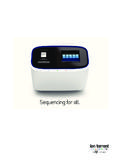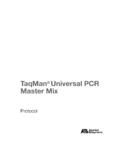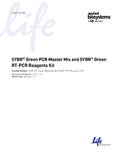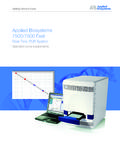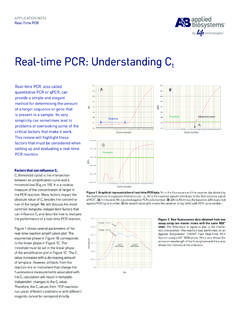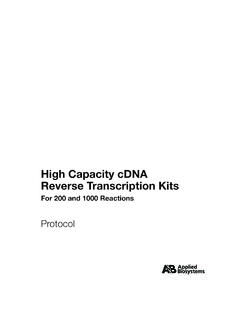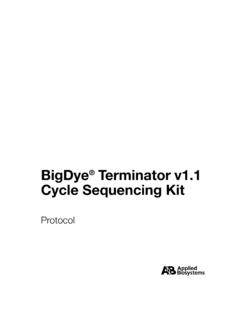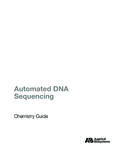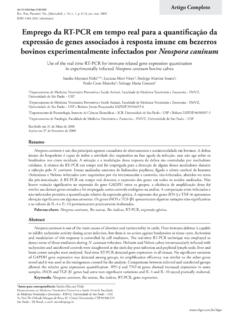Transcription of Guide to Performing Relative Quantitation of Gene ...
1 Guide to Performing Relative Quantitation of gene expression Using Real-Time Quantitative PCR. 1. Guide to Performing Relative Quantitation of gene expression Using Real-Time Quantitative PCR. Table of Contents Section I: Introduction to Real-Time PCR and Relative Quantitation of gene expression pg 4. 1. Introduction 2. What is Relative Quantitation ? 3. Terms and Acronyms 4. Relative Quantitation of gene expression Requires the Quantitation of Two Different Genes (Target and Endogenous Control). 5. Factors Affecting Accurate Real-Time PCR Results 6. What is PCR Amplification Efficiency? Section II: RNA Preparation and Reverse Transcription pg 14. 1. Introduction 2. Quantifying Input RNA. 3. Reverse Transcription (RT) for Relative Quantitation of gene expression a. Two-step RT-PCR. b. One-step RT-PCR. 4. Selecting Reverse Transcription and Real-Time PCR Reagents 5. Determination of Input RNA Amounts for a Relative Quantitation Study 6.
2 Identifying PCR Inhibition 7. How Much Genomic DNA Contamination can be Tolerated in a Relative Quantitation of gene expression Assay? Section III: Assay Selection and Design for Relative Quantitation pg 30. Selecting or Designing Primers and TaqMan Probes for Relative Quantitation of gene expression 1. TaqMan gene expression Assays 2. Custom TaqMan gene expression Assays 3. TaqMan MicroRNA Assays 4. Use of Primer Express Software for the Design of Primer and Probe Sets for Relative Quantitation of gene expression 5. Design of Assays for SYBR Green I Applications Section IV. Identification and Selection of Endogenous Controls for Relative Quantitation pg 37. 1. Uniformity of Endogenous Control expression . 2. Validation of Target and Control Genes for the Comparative CT Method 3. Multiplexing Endogenous Controls and Target Genes Section V. Customized and Pre-Configured Relative Quantitation gene expression Products pg 39.
3 1. TaqMan Low Density Arrays (Custom). 2. TaqMan Low Density Arrays gene Signature Arrays 3. TaqMan Cytokine gene expression Plate 1. 4. TaqMan Human Endogenous Control Plate 2. Section VI. Ordering Real Time PCR Reagents pg 42. Section VII. Relative Quantitation of gene expression Experimental Design and Analysis pg 43. 1. Introduction 2. The Relative Standard Curve Method a. Example of the Standard Curve Method: Using an Independent Sample for a Standard Curve b. Standard Deviation Calculations Using the Standard Curve Method pg 52. 3. The Comparative Ct Method ( CT Method). a. A Validation Experiment is Necessary to Determine if your CT. Calculation is Valid b. Plotting the Results of the Validation Experiment c. Validation Experiment Results d. The Comparative CT Method ( CT Method): Data Analysis Example e. What if a CT Value is Positive? Appendix A Definitions pg 60. Appendix B Reagents, Protocols, and Supporting Documentation pg 64.
4 3. Section I. Introduction to Real-Time PCR and Relative Quantitation of gene expression 1. Introduction Real-time quantitative PCR offers researchers a powerful tool for the Quantitation of target nucleic acids. To understand the value that real-time PCR provides over traditional PCR methods and to obtain basic information on chemistries and strategies, you can review the following tutorials: Real Time PCR vs. Traditional PCR. Essentials of Real Time PCR. This document guides you through Performing Relative Quantitation of gene expression using real-time PCR technologies developed by Applied Biosystems. It assists you in understanding the foundations of Relative Quantitation and provides guidance for selecting assays, experimental strategies, and methods of data analysis. The information presented is relevant for all instrumentation, reagents, and consumables provided by Applied Biosystems.
5 This tutorial expands on many of the topics that are introduced in User Bulletin #2: Relative Quantitation of gene expression . Throughout this tutorial there are many hyperlinks to external sites, documentation, and links to pages within this document. After you go to one of these hyperlinks, click the back button on your browser to return to your original location in the document. Applied Biosystems offers a variety of systems on which real-time quantitative PCR can be performed. These real-time PCR instruments are: Applied Biosystems StepOne Real-Time PCR System Applied Biosystems StepOnePlus Real-Time PCR System Applied Biosystems 7300 Real-Time PCR System Applied Biosystems 7500 Real-Time PCR System Applied Biosystems 7500 Fast Real-Time PCR System Applied Biosystems 7900HT FAST Real-Time PCR System ABI PRISM 7000 Sequence Detection System 4. 2. What is Relative Quantitation ? Methods for Relative Quantitation of gene expression allow you to quantify differences in the expression level of a specific target ( gene ) between different samples.
6 The data output is expressed as a fold-change or a fold-difference of expression levels. For example you might want to look at the change in expression of a particular gene over a given time period in a treated vs. untreated samples. For this hypothetical study, you can choose a calibrator (reference) sample ( untreated at day 0) and an endogenous control gene to normalize input amounts. For all samples, levels of both target and endogenous control genes would be assessed by real- time PCR. The results (target levels normalized to endogenous control levels) would then be expressed in a format such as At day 30, sample A had a 10-fold greater expression level of the target gene than at day 0 . If you want to obtain absolute quantities of gene targets you need to perform absolute Quantitation , which is beyond the scope of this document. Please see the following for more information about setting up and analyzing absolute Quantitation (standard curve experiments): Applied Biosystems 7300/7500/7500 Fast: Absolute Quantitation , Using Standard Curve Getting Started Guide Applied Biosystems 7900HT: Absolute Quantitation , Using Standard Curve Getting Started Guide Applied Biosystems StepOne : Standard Curve Experiments Getting Started Guide 3.
7 Terms and Acronyms The following terms and acronyms are used throughout this document. Additional information on specific definitions is available in Appendix A or by clicking on the appropriate links. Terms/ Definition Acronyms Active An active signal used to normalize experimental results. Endogenous reference controls are an example of an active reference. Active reference means the signal is generated as a result of PCR amplification. The active reference has its own set of primers and probe. Amplicon A PCR product generated from a DNA or cDNA template. Amplification The rate at which a PCR amplicon is generated, commonly measured efficiency as a percentage value. If a particular PCR amplicon doubles in quantity during the geometric phase of its PCR amplification then the PCR assay is said to have 100% efficiency. The value assigned to the efficiency of a PCR reaction is a measure of the overall performance of a real-time PCR assay.
8 Baseline The background fluorescence signal emitted during the early cycles of the PCR reaction before the real-time PCR instrument detects the amplification of the PCR product. Calibrator A sample used as the basis for comparative expression results. See also reference sample. CT Threshold cycle. The CT is the cycle number at which the 5. fluorescence generated within a reaction crosses the threshold line. CT values are logarithmic and are used either directly (comparative CT. method) or indirectly (interpolation to standard curves to create linear values) for quantitative analyses. Custom Custom TaqMan gene expression Assays are products designed, . TaqMan gene synthesized, and delivered as pre-mixed primers and TaqMan MGB. expression probe sets based on sequence information submitted by the Products customer. Custom Custom TaqMan Genotyping Assays are products designed, TaqMan synthesized, and delivered as a set of pre-mixed primers and Genotyping TaqMan MGB probes based on sequence information submitted by Products the customer.
9 Dynamic range The range (maximum to minimum) of sample concentrations or input amounts that a given assay is capable of detecting. Endogenous A gene sequence contained in a sample that is used to normalize control target quantities. In addition to the target sequence, an endogenous control is quantified as a means of correcting results that can be skewed by input nucleic acid loading differences. Endogenous controls are an example of an active reference. Experimental An amplification that uses the same PCR reagents as another replicate amplification and that uses template preparations from similar but not identical samples. Experimental replicates provide information about the overall precision of the experiment. For example, if you want to examine the effect of drug treatment on the level of a mouse mRNA, you would treat multiple mice identically with the drug to determine the variation of response in the mouse population.
10 A group of ten mice would represent ten experimental replicates. Identical An amplification performed in multiple wells using the same template replicate preparation and the same PCR reagents. Identical replicates provide: (Technical Data preservation: If amplification fails in one well, replicates in Replicate) other wells can potentially provide data. Monitoring: Replicates can be used to monitor the precision of the PCR amplification and detection steps. Passive A dye that provides an internal fluorescence reference to which the reference reporter dye signal can be normalized during data analysis. The reference dye does not participate in the PCR reaction. This normalization corrects for fluorescence fluctuations that are caused by changes in reaction concentration or volume. Failure to use a passive reference dye can compromise accurate target Quantitation . Applied Biosystems incorporates the internal passive reference dye ROXTM in all of its real-time PCR chemistries.

